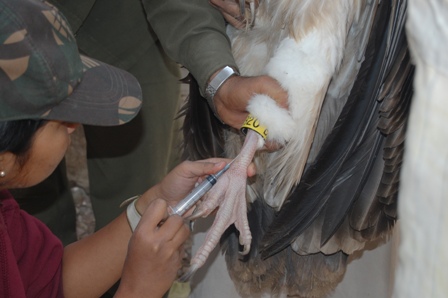Husbandry and Care of Vulture
Husbandry and care is possibly the most important component of any conservation breeding programme. The correct procedures followed ensure a healthy population in captivity.
The protocols for husbandry and care followed at the centre have been developed in consultation with international organisations with expertise in captive management of birds. A number of modifications have been made based on our experience and local circumstances. The following parameters are covered in routine husbandry and care of vultures.
Identification
 When a vulture is brought to the centre, a strong plastic ring etched with a number is put on one of the legs and a microchip is implanted in its breast muscle for identification.
When a vulture is brought to the centre, a strong plastic ring etched with a number is put on one of the legs and a microchip is implanted in its breast muscle for identification.
Health Check
Different examinations are carried out for providing veterinary care to vultures. A physical examination of vultures in quarantine is carried out three times during the quarantine period of 45 days. The initial check up is carried out for any signs of injury or fracture. Once out of quarantine period, vultures at the centre are physically examined once a year. Daily visual examination is carried out four times in a day. The examination is done from a distance usually through binoculars or through CCTV monitors. It includes the evaluation of the general appearance, attitude and activity of individual bird. These are the main parameters that are likely to change in response to a disease condition.
Laboratory examination involves haematology, parasitology, and basic microbiology on live birds and necropsy on dead vultures which gives a clue of the health condition of the vultures. The centre has a lab which is equipped to carry out all this. Post mortem examination is carried out by using a standard protocol, which includes systematic visual examination of external and internal organs.
Feeding the Vultures
 Vultures are fed on freshly slaughtered skinned goats. Each vulture is provided with 3-4 kg of meat per week depending on the body weight; spread over two days, to maintain its daily food requirement of 5% of its body weight. To ensure that there is no diclofenac in the tissues of the goat carcasses, a herd of goats is kept in the care of the centre for at least ten days before slaughter.
Vultures are fed on freshly slaughtered skinned goats. Each vulture is provided with 3-4 kg of meat per week depending on the body weight; spread over two days, to maintain its daily food requirement of 5% of its body weight. To ensure that there is no diclofenac in the tissues of the goat carcasses, a herd of goats is kept in the care of the centre for at least ten days before slaughter.
Aviary Maintenance
Aviary maintenance is critically important for ensuring the good health of the captive vultures. Routine and annual maintenance of aviaries are regularly carried out at the centre.
Perches
Special attention is given to the perch management in the aviary. Perches at different heights are provided with uneven surfaces. Coconut rope is wound around the perches for giving it a rough surface. This prevents foot problems which are common in captive raptors.
Water
Water is provided in cemented troughs inside the aviaries. Four water troughs are provided. The troughs are cleaned from outside once a week and water is topped up every day.


